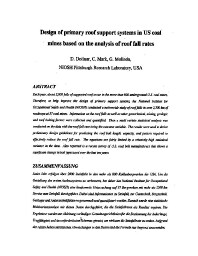Mining Publication: Design of Primary Roof Support Systems in U.S. Coal Mines Based on the Analysis of Roof Fall Rates
Original creation date: June 2001
Authors: DR Dolinar, C Mark, GM Molinda
NIOSHTIC2 Number: 20021291
Proc Fourth Intl Symp on Roof Bolting in Mining, Aachen, Germany, Martens-PN ed., Druckerei Mainz GmbH; 2001; ::235-252
Each year, about 2,000 falls of supported roof occur in the more than 800 underground U.S. coal mines. Therefore, to help improve the design of primary support systems, the National Institute for Occupational Safety and Health (NIOSH) conducted a nationwide study of roof falls in over 2,500 km of roadways at 37 coal mines. Information on the roof falls as well as other geotechnical, mining, geologic and roof bolting factors were collected and quantified. Then a multi variate statistical analysis was conducted on the data with the roof fall rate being the outcome variable. The results were used to derive preliminary design guidelines for predicting the roof bolt length, capacity, and pattern required to effectively reduce the roof fall rate. The equations are fairly limited by a relatively high statistical variance in the data. Also reported is a recent survey of U.S. roof bolt manufacturers that shows a significant change in bolt types used over the last ten years.

NIOSHTIC2 Number: 20021291
Proc Fourth Intl Symp on Roof Bolting in Mining, Aachen, Germany, Martens-PN ed., Druckerei Mainz GmbH; 2001; ::235-252
- Analysis of Roof Bolt Systems
- Diagnosing and Controlling Moisture-Sensitive Roof in Coal Mines
- Factors Influencing Intersection Stability in U.S. Coal Mines
- The Introduction of Roof Bolting to U.S. Underground Coal Mines (1948-1960): A Cautionary Tale
- Mistakes, Misconceptions, and Key Points Regarding Secondary Roof Support Systems
- Optimizing Secondary Roof Support with the NIOSH Support Technology Optimization Program (STOP)
- Overview of Coal Mine Ground Control Issues in the Illinois Basin
- Performance Characteristics for Welded Wire Screen Used for Surface Control in Underground Coal Mines
- Preventing Falls of Ground in Coal Mines With Exceptionally Low-Strength Roof: Two Case Studies
- Preventing Injuries Caused by Unrecognized Stone Mine Roof Beam Failures With a Pro-Active Roof Control Plan